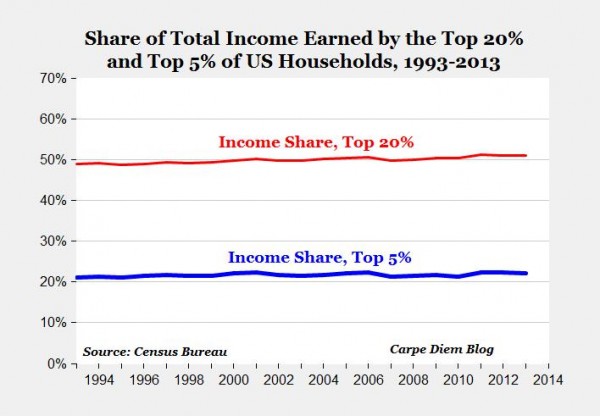Economics professor Mark Perry of the University of Michigan-Flint examines for the American Enterprise Institute the notion popularized by Thomas Piketty and others that the United States faces a problem of growing income inequality.
We hear all the time about “rising income inequality” in America (there are about 1 million Google search results for that term), about “the rich getting richer and the poor getting poorer,” the “stagnant or disappearing middle class,” all of recent income gains going to the rich,” the lack of income mobility and other narratives of pessimism. And yet, nobody seems to have shared those negative narratives with the Census Bureau, which released new data today on “Income and Poverty in the US: 2013,” because some of those data tell a slightly different story.
1. The top chart above shows the shares of total income earned by the top 20% and top 5% of US households from 1993 to 2013 (from Table A-2). In 1993, 49% of total income went to the top quintile of US households, and 20 years later in 2013, the share of income going to the top 20% has increased to only 51%. Likewise, in 1993 the share of total income going to the top 5% of US households was 21%, that share had increased to only 22.2%. Interestingly, the 22.5% share last year was slightly lower than the 22.4% of income that went to the top 5% in 2001. Over the last two decades, the income share of the top 20% (top 5%) has been remarkably stable at about 50-51% (21-22%) and there has been no statistical evidence of “rising income inequality” according to this measure. …
… [T]here is absolutely no statistical support for the commonly held view by the public, academia and the mainstream media that income inequality has been rising in recent years or decades. A more accurate description of income inequality over the last several decades would be to say that it “flat-lined” starting in about 1993.



